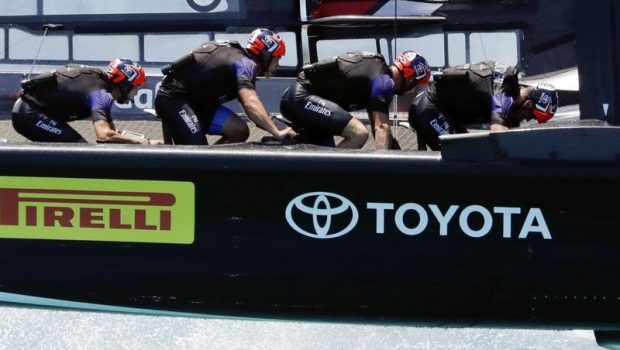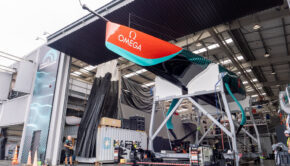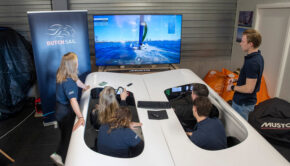America’s Cup: When a Plan Comes Together
Published on June 21st, 2017
When five America’s Cup teams choose hand cranks, and one team choose pedal power, the lone wolf is either brilliant or completely daft. For Challenger Emirates Team New Zealand, their move to leg muscles has silenced the critics. Bernie Wilson of the Associated Press reports.
One of the Kiwi cyclors, 28-year-old Simon van Velthooven, has an Olympic bronze medal in track cycling. He might soon be an America’s Cup champion if the Kiwis’ astoundingly fast design package, of which the cycling system is just one component, whisks them to victory against two-time defending champion Oracle Team USA.
The Kiwis replaced grinders and their arm power with the cyclors. Their pedaling powers the hydraulic systems used to power all the features on the boat.
The actual sailing is done by helmsman Peter Burling, 26, an Olympic gold and silver medalist; skipper Glenn Ashby, 39, an Olympic silver medalist and multihull whiz who controls the wingsail with an Xbox-like device; and Blair Tuke, 27, Burling’s Olympic teammate who has a dual role of cyclor and foil trimmer.
This is the first time cyclists have powered a boat in the America’s Cup match. A Swedish team tried a cycling system in an unsuccessful challenge in 1977.
“If you have half a brain and you know that your legs are stronger than your arms, why wouldn’t you give it a go?” van Velthooven said.
The underfunded but always crafty Kiwis, the hard-luck losers in the 2013 America’s Cup, began secretly working on the cycling system three years ago in Auckland. When their test boat was launched in February, there was surprise and skepticism from outsiders.
Oracle, of course, had team members watching from a spy boat.
“I think they said, ‘Ah, we heard rumors that you’ve been testing but we never thought you’d actually bloody do it,’ ” van Velthooven said. “It was good to keep it 100 percent secret until the boat rolled out.”
Other than the bike seats that can be seen in the cockpits, little is known of the system. And the Kiwis aren’t real chatty about it.
“It doesn’t look like a bike at all. Just imagine a set of cranks and that’s about it, really,” van Velthooven said.
Does it have a chain?
“No comment. Not yet,” he said.
He does let on that the cyclors wear mountain bike shoes and use mountain bike pedals.
“It’s purely high performance and it does its job well and it’s been designed well and it’s been designed really light,” van Velthooven said.
Van Velthooven said he learned to sail while growing up but veered into cycling. He won the bronze medal in keirin at the 2012 Olympics. When he didn’t make the world championship team for track cycling in 2015, Team New Zealand called and asked him to test their cycling system.
“It was a big hurdle when they actually put the test bikes in the race boat,” he said. “They had mocked it up in the shed. It looked funny then to us. We were either going to be the laughingstock or the best power source the Cup has seen. It’s worked out well.”
Van Velthooven’s spot is in front. On days when there are multiple races, he swaps out with Joe Sullivan, an Olympic rowing champion.
“Position one is more of a mercenary. We just go as hard as we can and let the other guys not pedal as hard so they’re dialed in for all the races,” van Velthooven said.
Van Velthooven calls the cyclor system “a 10th of 10 different things that are all working at the same time to give a package that’s 100 percent awesome.
“Blair and Glenn have almost unlimited hydraulic fluid to play with when racing gets heated. It’s just awesome that it’s all worked out, all the ideas that the designers had and then for the machinists and boat builders to build it, and then to go out there on the water and actually see it working as we dreamed it, is a pretty awesome thing to deliver for the boys.”
Overall Results*
Emirates Team New Zealand (3) vs ORACLE TEAM USA (0)
* Scoreboard: While the Challenger has won all four races, their match score is 3-0. The Defender, which won the Qualifiers held on May 26-June 3, began the series with a one point advantage. As the rules detail, the Challenger would carry a one point disadvantage (ie, minus 1), meaning they will need to win eight races to take the trophy whereas the Defender need only win seven races.
Schedule: The dates of the Match extend from June 17 to 28, though will end earlier when a team scores 7 points. The next race day is June 24 and will continue daily thereafter until there is a winner.
Event details – Results – Facebook
Here are the answers to these questions…
• What is the racing schedule? Click here
• What is the competition format? Click here
• How can I watch the racing? Click here









 We’ll keep your information safe.
We’ll keep your information safe.